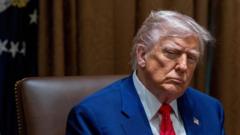In a week marked by significant upheaval, President Donald Trump has hit pause on his previously announced tariff plan, which aimed to reshape global trade relations and established alliances. While he has temporarily suspended higher tariffs for 90 days, his aggressive pursuit of a trade conflict with China raises questions about the feasibility of his trade goals. Here’s a rundown of Trump's major ambitions and their current status:
1) **Revamped Trade Deals**
Trump's striking proposal initiated a flat 10% tariff affecting numerous countries and additional tariffs on a select group deemed "worst offenders." The plan rattled foreign leaders, prompting over 75 countries to reach out for negotiations. Recently, the U.S. has entered talks with partners like South Korea and Japan, with the 90-day countdown for potential agreements commenced. The outcome remains uncertain, yet progress is evident.
2) **Revitalization of American Industry**
Trump has long championed tariffs to restore U.S. manufacturing. However, the inconsistency of the tariff landscape creates instability, deterring businesses from committing to significant investments. With fluctuating tariffs, companies are likely to proceed cautiously, delaying reshoring efforts and production expansions.
3) **Confrontation with China**
Trump's recent move has emphasized a focus on China, which he accuses of exploiting U.S. economic policies. Despite the escalating tensions, there's a hint from administration officials about a potential de-escalation. The stakes are high; any prolonged confrontation could have far-reaching implications for global economies and could jeopardize crucial international alliances in the process.
4) **Revenue Generation**
Trump's campaign promised that the heavy tariffs would yield substantial revenue, estimated at $2 trillion over a decade from a 10% universal tariff. This influx was to fund tax cuts and reduce national debt. However, switching to more domestic production could reduce this expected revenue stream, placing pressure on Trump's fiscal promises.
5) **Consumer Price Stability**
The president has suggested that increased domestic production would lead to lower consumer prices. Yet, experts caution that tariffs are likely to elevate costs for consumers, challenging Trump's assertion. Predictions indicate that households could see a $1,253 increase in their expenses within the first year of a universal tariff implementation, disproportionately affecting lower-income families.
As Trump navigates the rocky terrain of trade negotiations, the coming weeks will be pivotal. The outcomes of these economic strategies may have lasting ramifications on both the U.S. economy and Trump's political support.
1) **Revamped Trade Deals**
Trump's striking proposal initiated a flat 10% tariff affecting numerous countries and additional tariffs on a select group deemed "worst offenders." The plan rattled foreign leaders, prompting over 75 countries to reach out for negotiations. Recently, the U.S. has entered talks with partners like South Korea and Japan, with the 90-day countdown for potential agreements commenced. The outcome remains uncertain, yet progress is evident.
2) **Revitalization of American Industry**
Trump has long championed tariffs to restore U.S. manufacturing. However, the inconsistency of the tariff landscape creates instability, deterring businesses from committing to significant investments. With fluctuating tariffs, companies are likely to proceed cautiously, delaying reshoring efforts and production expansions.
3) **Confrontation with China**
Trump's recent move has emphasized a focus on China, which he accuses of exploiting U.S. economic policies. Despite the escalating tensions, there's a hint from administration officials about a potential de-escalation. The stakes are high; any prolonged confrontation could have far-reaching implications for global economies and could jeopardize crucial international alliances in the process.
4) **Revenue Generation**
Trump's campaign promised that the heavy tariffs would yield substantial revenue, estimated at $2 trillion over a decade from a 10% universal tariff. This influx was to fund tax cuts and reduce national debt. However, switching to more domestic production could reduce this expected revenue stream, placing pressure on Trump's fiscal promises.
5) **Consumer Price Stability**
The president has suggested that increased domestic production would lead to lower consumer prices. Yet, experts caution that tariffs are likely to elevate costs for consumers, challenging Trump's assertion. Predictions indicate that households could see a $1,253 increase in their expenses within the first year of a universal tariff implementation, disproportionately affecting lower-income families.
As Trump navigates the rocky terrain of trade negotiations, the coming weeks will be pivotal. The outcomes of these economic strategies may have lasting ramifications on both the U.S. economy and Trump's political support.




















